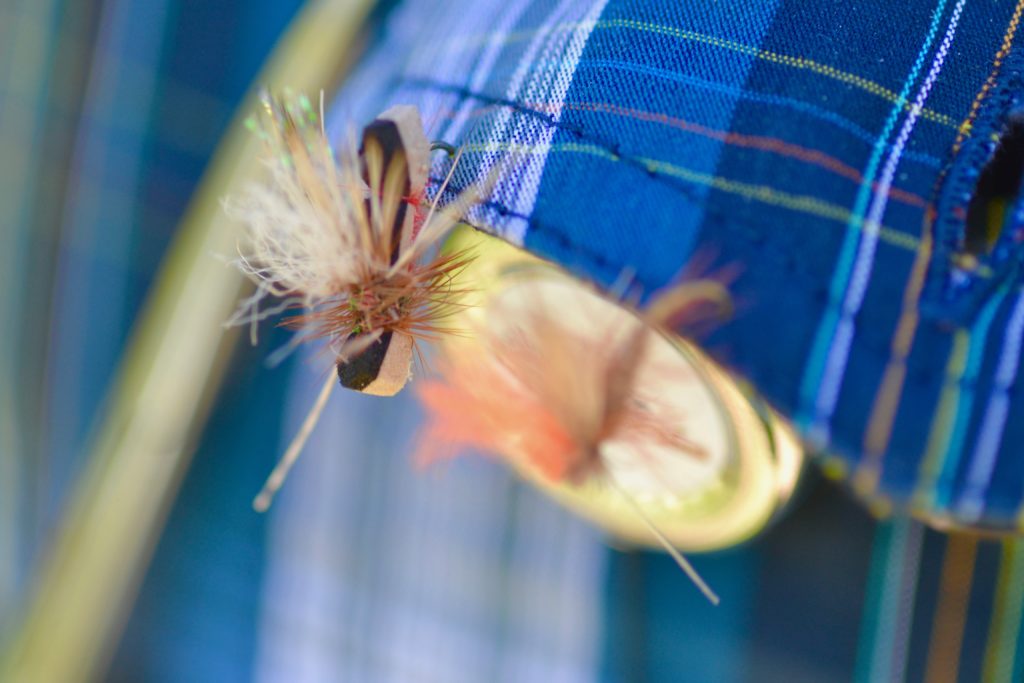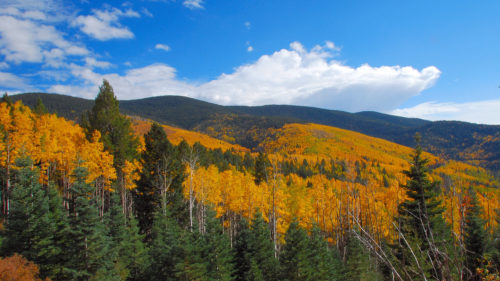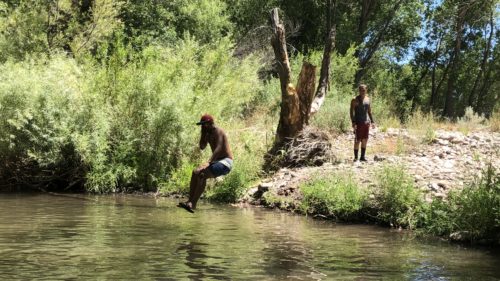There’s something magical about fishing small streams. I mean a stream of about 100 cubic feet/second (cfs), or less. Such a stream is large enough to hold a trophy, relatively speaking, but small enough that you can hike it, and fish it, and cross it on foot. You can come to know a stream like that intimately. That’s nice; a step towards quality fishing.
Another step towards quality fishing is to fish a small stream with a fly rod, albeit the singular aspect that an artificial fly brings to the sport may be hard to define. But consider the literary luminaries that have been thus inspired by fly and small stream – Ernest Hemingway, Arnold Gingrich, Norman MacLean.
Of course these notables all fly fished their small streams for trout. Nothing discounted there — brook trout, browns, rainbows, cutthroats, et al are justifiably known as “game” species. But North American fishing lore has long had it – since 1881 and Dr. James Henshall’s Book of the Black Bass — that the “gamest fish that swims” (at least in fresh water) is “inch for inch and pound for pound” the smallmouth bass. Once confined to the northeastern states and southeastern Canada, with stocking, both official and surreptitious, this species is now naturally reproducing in a variety of waters in virtually every state, including wilderness areas in the great Southwest.
My own proving ground for this singular sport has been primarily the headwaters of the Gila River found in the nation’s first designated Wilderness, the Gila. Set aside by the Forest Service in 1924 at the literate urging of one Aldo Leopold, it features the usual habitats that you would associate with a western states mountain trout stream – a descending sequence of shallow riffles grading into pocket water and a deep run, then whitewater rapids that gather oxygen while cascading into a deep pool. The first time I tried it for fish some 35 years ago, I was expecting trout. And I did catch a few rainbow/Gila trout hybrids from the deeper runs and whitewater. Then I botched it.
I topped a high bank and found myself peering down into a deep pool with almost no current and the water so clear it looked like you could touch the bottom without getting your hand wet. And swimming around in there, amongst the Gila chub and Sonoran suckers, were a half dozen, good-sized smallmouth bass.
Smallmouth bass? I kept looking (probably too long) and not believing, for Mother Nature never put a smallmouth within 500 miles of the Gila River. But some people obviously did; I would learn later it was the New Mexico Department of Game and Fish with two stockings in the 1940s. And the pool was lucid as an aquarium – those were bass all right!
I carefully removed myself from my perch on the bank, tied on a wooly bugger to replace the nymph I’d been using for the trout, and blind cast to the pool. I caught only a big chub and got my first lesson in fishing small streams for big bass. Because a small stream may offer an intimate setting, and because we all like to cast to sighted fish, it’s a temptation to get too good a look at your quarry. But if you can see him, he can probably see you. If he sees you, especially if he sees you throwing a fly his way, you’re probably not going to catch him.
Later that day, on my return hike to the truck, I approached this pool from upstream and cast from a distance. The black wooly bugger sailed to a soft landing. I played out some slack to minimize the drag, and got a hard hit from a bronze bass 16-inches long. He jumped twice, raced around the pool, went deep and pumped the rod, and generally did all the things you’d expect the “gamest fish that swims” to do before allowing himself to be released in the shallows. I now knew something of the special delights in fishing for the same fish with flies in a small stream.
That this fish was, while not truly native, born and raised in the nation’s first Wilderness area, only added to the esoteric quality of the event. I went home thinking, “you’re odds are always better if they don’t know you’re there.”
Of course the water in the small stream is not always crystal clear; in fact, it’s usually not. If it’s murky, or if wind or current makes even small waves or riffles on the surface, the fly fisher can get closer to the fish without being seen. The bass will likely still be in the deep, slow run or pool however, and the trout, like those Gila River hybrids, will still tend to favor the faster water. In that situation, I like to make an upstream quartering cast with sinking fly of some sort (more on this later) to the head of the pool, and though I probably can’t see the fish holding head into the current, when the bass hits the fly I’ll see a flash as he turns on the take. I know then to put a quick bend in the rod and hook him. If I don’t see a flash I may still see the line “check” on the take and, again, I know to strike quickly. And then there’s something called a strike indicator, a bobber by any other name. I don’t use them but for those who do, you know how they offer a big advantage for a soft take by a bass as well as trout.
Some trout fishers will lose sleep over matching the hatch, or dry fly versus wet fly debates, making trout fishing with flies complex and confounding – or at least seem to be. For example, on the quality tailwaters section of the San Juan River, guides will put their clients on to 20+-inch trout with a tiny midge or San Juan worm imitations using a #22 or even #24 hook. It works – big trout take those miniscule flies, but I had the devil of a time even getting the tippet through the eye!
Despite the name, a 20-inch, or even 12-inch, smallmouth has a much bigger mouth than a trout of equal size and the bass wants something more substantial. In a stream environment, the bass will likely feed all year on hellgrammites, as the larval stage of the Dobson fly can only survive to metamorphose with running water. Bass just hammer them, and they’ll hammer a well-tied, black or brown, wooly bugger, #6 to #10 hook, imitation hellgrammite just as hard. A green wooly bugger, same size, looks something like a tadpole in the water; whatever, bass will hammer them too. Two other natural foods that smallmouth love and find in most any stream are the crawfish and the grasshopper. Of course there are a variety of “flies” that imitate these food sources too. I like to fish both deep, bouncing along the bottom with a small split shot about a foot above the fly. Some friends of mine – more accomplished than I with a fly rod – agree with me on the crawfish technique but have the knack of fishing the hopper imitation on the surface. Both methods work. but I have to admit there is a special joy in seeing a big stream bass boil up and take a big fake hopper or popping bug off the surface like it was a real insect.

All of the above flies are imitators. But Harold Blaisdell in his almost forgotten classic The Philosophical Fisherman reminds us that all fishing with artificials – fly, plug or spoon — is either imitative or provocative in nature and he reminds us to consider the provocative fly or lure. He laughs at the notion that a game fish thinks a dare-devil for example is a minnow; in fact the lure resembles nothing that swims in fresh water. Yet it provokes an angry response in fish that may cause that fish to give the lure a hell of a belt – sometimes including when the fish is not even hungry.
You can’t cast a dare-devil with a fly rod rigging but you can cast a Pistol Pete and elicit an angry response in stream bass. This “bug” features a #6 to #10 hook feathered out in various colors and shapes to resemble nothing in particular but is nonetheless attractive to game due to the fuzzy appearance and tiny propeller spinning at the head of the fly and just behind the eye of the hook. By my experience, that spinning prop at the head of a fuzzy fly drives stream bass nuts, albeit some of these flies look more like Christmas tree ornaments than real food.
All of the flies described here are usually fished best upstream, when that cast is available, and followed down on dead drift and an almost-tight line; tight enough that you’ll see the line “check” when the fish takes but not so tight that it spoils the naturalness of the drift. Then when the fly comes round at the downstream end of the run or pool, jig it back upstream; you’ll be surprised how often the upstream “flight” of the fly, though it’s not the natural movement of hellgrammite or hopper for example, will draw a strike.
Fly rod rigging is simple enough for stream bass. A 5 to 7 wt. rod with matching wt. floating line and 6 to 8 feet of leader will handle most applications. I use a little heavier tippet for stream bass than for stream trout – 3X (about 6 lb. test) to 1X (about 9 lb. test) depending on the weight of the fly and anticipated size of the fish. With that outfit you’re ready for even over-size smallmouth bass. Which begs the question . . .what’s oversize?
The Middle Fork of the Gila River has a base flow of perhaps 25 cfs and one recent summer during a prolonged drought it was less than that. Yet even when it appears water-starved it, like lot of small streams, maintains some deep runs and pools that remain cool enough for trout yet warm enough for smallmouth bass, even a bass that reaches my admittedly arbitrary mark for “oversize” of 20-inches. I made a hike up there one memorable day to see what remained of water and fish in the midst of an extra-dry year. And I found one short stretch of habitat that was particularly intriguing.
There was a stout limb bobbing in the current and deflecting the flow across a fast, deep run. It was fast and deep only in relative terms as you could practically jump across the stream here, but it had enough flow that you couldn’t see the bottom. I thought, ”there’s got to be a trout under that limb.” And ten yards downstream the stream funneled a backwash pool into a notch in the cliff wall and it too was deep but slow and I thought, “there’s got to be a bass in that honey hole.”
I was right on both counts and caught the trout first, a 15-inch brown on a bead-head nymph. Then I went downstream for the bass. I changed flies to a dark brown wooly bugger. And while nobody will ever offer me a job as a fly casting instructor, I got lucky and hit the center of that pool on the first throw. A big smallmouth took it with force and a second later made his first jump. It looked like 20-inches to me! Several jumps later, seemingly worn down now and laying in the shallows, he looked even bigger than that. But I’ll never know because as soon as he felt my hand he exploded one last time and left me with water in the face, mud on my dark glasses, a brown wooly bugger recently thrown that I could thankfully use again, and empty hands.
Of course, I would have let him go anyway. And he’s still out there somewhere, the gamest fish that swims, awaiting your fly in Aldo Leopold’s Wilderness.



